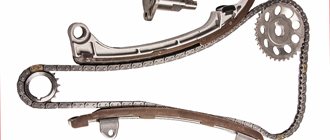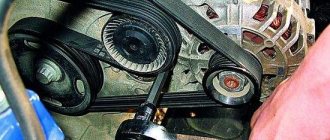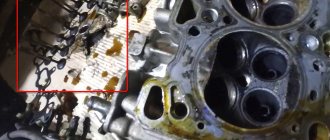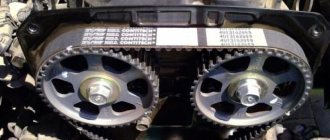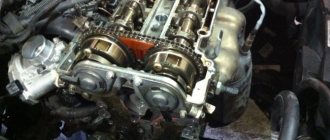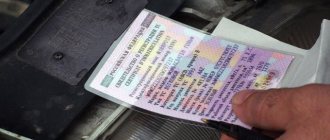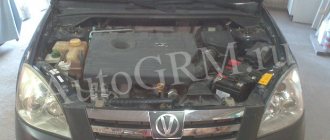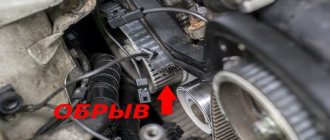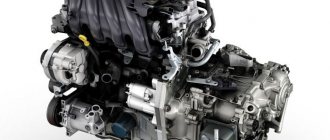Consequences and causes of timing belt breakage
The consequences of a break depend on the type of engine, the presence of grooves on the pistons, the quality of the parts and the reasons for the timing belt break.
The most common consequences:
- Buying and replacing a belt
- Engine repair.
- Overhaul of the entire engine.
- The need to repair the entire gas distribution mechanism. The most significant problem is bent engine valves that cannot be repaired. This problem most often affects cars in which the combustion chamber is reduced or the pistons do not have recesses. In order to accurately determine the level of damage, you need to take the car to specialists.
- Sections of the piston system are deformed. Such damage most often occurs in Japanese cars. When the blade breaks at high speed, the bushing breaks and the pistons are damaged by the fragments. The consequences are an expensive replacement of all parts.
Diesel engines suffer serious consequences after the fabric breaks.
Car owners will need to replace a number of main parts of the gas distribution mechanism:
- Camshaft.
- Cylinder head.
- Connecting rods.
- Valves.
The average cost of a valve is about one thousand rubles (excluding replacement). To calculate the total cost, you need to take into account the number of valves that need to be replaced. If there are sixteen of them, the total cost will be high.
Additionally you need to buy small parts:
- Timing belt or complete timing gear kit with all bearings.
- Cylinder head gaskets and manifolds.
- Valve plugs.
- Fasteners.
- Pump (all belt manufacturers recommend changing the pump at the same time as the timing belt)
If the driver carries out car repairs himself, he will also need various tools
How serious the consequences of a broken timing belt will be for your car is directly related to the design of the engine; the simpler it is, the less likely it is to damage it.
Most often they can entail:
- Engine overhaul.
- Restoration of the gas distribution mechanism.
- Bent valves – Occurs when the timing belt breaks as they are lowered to release gases or inject fuel. In this case, the crankshaft continues to rotate by inertia and is met by the pistons, which in turn can cause a strong blow to the valves. However, this problem is typical only for cars with a specially reduced combustion chamber or in the absence of sampling on the pistons. To determine the extent of damage, it would be best to transport the car to a service station, since it will be necessary to dismantle the cylinder head and diagnose the engine using special equipment. It would be best to replace the entire set of valves, even if at the time of the break, the engine was idling and only 3-4 of them were damaged.
- Piston failure - Most often occurs on Japanese cars and occurs from a strong impact with the valve heads. If the belt breaks at high speed and all the valves are bent, the bushings will burst and the pistons will be punctured by fragments. In this case, very expensive repairs will be required, including replacing the head.
The most serious consequences of a broken timing belt are observed in diesel engines, the design of which practically does not allow the valves to move, so if they break, when they are in the top dead center position, they can simultaneously become unusable:
- Camshaft with bearings
- Cylinder head
- Connecting rods are deformed
- Valve bends
No less influential on the consequences that a broken timing belt entails is its nature, because in some cases it does not break; instead, one or more teeth are cut off on it. In this case, both the crankshaft and the camshaft continue to rotate, striking all nearby parts with the pistons.
Similar damage can occur even if the belt teeth remain intact but jump over the teeth of the timing sprocket.
There are too many reasons why a timing belt can break, so we will focus on the most basic:
- Crankshaft jamming.
- Camshaft jamming.
- Jamming or spontaneous release of the tension roller.
- Pump jammed.
- Various foreign elements getting under the teeth.
- Regular exposure to dirt and oil.
- Aging of the belt, its natural wear and tear or original defects of the manufacturer.
Signs of a broken timing belt are very simple - the car suddenly stalls and can no longer be started, and when you try to turn on the ignition, you hear a metallic knock that occurs as a result of the pistons hitting the valves. A breakdown can cause serious problems; at high speeds, this is guaranteed to lead to valve failure, after which they will have to be replaced. In the worst cases, the pistons themselves, the pastels and the gaskets are damaged.
Due to the prevalence of the problem, some manufacturers make special recesses in the upper part of the piston to avoid “jamming” of moving parts. In this case, if the alternator belt breaks on the road, it will be quite simple to replace it. Therefore, it is recommended that every driver keep a spare belt and a set of tools necessary to replace it in the trunk.
The timing belt is extremely important for synchronizing all the internal parts of the engine. During a break, you may hear a roar, cracks and blows, or you may not hear anything, depending on the design features of the engine, it may simply bend the valves, or global damage may occur.
Most timing belts need to be changed between 80-100K (I personally change them at 60,000 - 65,000 kilometers; I’d rather pay more for the belt and weights - since I’m changing the whole assembly, but I’ll be calm about my engine). The cost of such a replacement varies for different cars, for example, for my Hyundai Santa Fe it costs $150-200 - this is work plus parts.
When your timing belt breaks, it can be a harrowing experience, depending on when it happens and what's going on around you. When my timing belt broke while on the highway at 60 mph, it was just a momentary loss of power, but no warning, no noise, no warning lights on the dash. This was in 2006 on a VW TDI.
If you are interested in what exactly happens when the timing belt breaks, then below is a far from complete list of what this usually leads to
- 100% engine overhaul (very expensive)
- Complete restoration of the car's gas distribution mechanism
- There is a high probability of destruction of the pistons, and therefore their complete replacement
- Deformation of connecting rods
- Bent valves
- Possible damage to the cylinder head
- Damage to the camshaft and bearings in pairs
Some belts can actually last up to 110,000km, others fail at 25,000km.
Therefore, now I drive a maximum of 65,000 km before replacing the belt, write if you have had something similar and at what mileage you replace the timing belts on your car.
You can determine that the timing belt has broken by the following “symptoms”:
- Abrupt stopping of the engine and inability to start it. Attempts to start the power unit only worsen the situation, since the piston causes new damage to the failed valve.
- After a belt breaks, engine operation may be accompanied by a metallic knock and ease of rotation of the crankshaft by the starter. This is due to the lack of compression in the engine cylinders, as a result of which nothing holds the pistons.
If the timing belt is broken, then:
- It is necessary to open the engine compartment and lift (or completely dismantle) the protective cover of the mechanism.
- It is important to carefully evaluate the appearance of the belt (the torn product will be visible). If it breaks at the very bottom, you will need to turn the crankshaft half a turn to find it.
- The vehicle must then be towed to a garage or service station. If the car is equipped with an automatic transmission, the assistance of a tow truck will be required, since towing is not allowed on such vehicles.
Symptoms of a break
The timing belt is good for everyone, but unlike the whistling alternator belt, it breaks without any signs of it. It’s clear how the engine’s performance changes when the belt breaks - it stalls, which is why the battery icon and oil can light up even on the meager panel, and the accelerator pedal does not respond. This ends the list of safe symptoms of the problem. Yes, they may advise you to crank the engine with the starter and it will definitely not start. But later you will understand that this is fraught and, moreover, in the absence of experience, does not definitely indicate that the belt drive has failed.
This is interesting: Lambda probe malfunction: signs, symptoms and testing
Due to the actual absence of symptoms of a break, they do not like the belt, knowingly treating it with caution. After all, in fact, you can make sure that it is torn only by opening the plastic timing case or opening the inspection window, if one is provided for by the protection design. If you think about it for a moment, this must be done after every sudden stop of the engine, even if it was caused by an electronics failure. As they say, it's better to be safe...
It is rare that a break is preceded by any squealing or other noise. In this vein, everything usually goes silently.
Why does the belt break?
Causes of product damage:
- low quality belt;
- errors made during installation or replacement;
- failure of the tensioner rollers;
- wear of the belt teeth (the teeth wear out constantly during the operation of the car);
- pump jamming;
- foreign objects entering the gas distribution mechanism.
The service life of modern new products for distribution mechanisms depends on the make of the car and is about 150 thousand kilometers (on older cars this figure is lower - about 70 - 100 thousand / km). If the vehicle is used in low temperature conditions, the service life of the belt is reduced to 60-100 thousand/km. In any case, experts recommend diagnosing the condition of the timing belt at least every 15 thousand kilometers.
Quality of spare parts
Quality determines the correct ignition of the air-fuel mixture, which affects the efficiency of the power unit. Installing and using cheap products in the machine can cause low drive tension, which will result in the belt quickly bursting.
Errors made when installing the timing belt lead to asynchronous opening and closing of the valves, resulting in reduced engine power. The cause is usually too loose or too high a tension on the shafts. If the replacement of the product was carried out with errors, it may break after 1-2 thousand kilometers.
Characteristic signs of incorrect replacement:
- the product slides to the side;
- cracks have appeared or become noticeable on its surface;
- An unusual sound is heard when the engine is running.
Tensioner rollers are designed to tension the belt on the engine shafts, so that it does not jump off while the engine is running. If the tension is weak, the strap will begin to slip, which will cause an increase in temperature and rapid wear of the auxiliary units. If the tension is excessive, the product can quickly burst, and a characteristic symptom will be a sharp sound from under the hood.
With serious wear, the rubber teeth located in mesh with the shaft gears break off. With such a problem, the engine may not start, although the belt itself appears to be intact. The operation of the power unit as a result of tooth destruction is disrupted, as this leads to a failure of the ignition system.
Pump wedge
If the pump is jammed, it may not respond to turning, which leads to strong tension and breaking of the belt while the vehicle is moving. This problem is more relevant for domestic vehicles.
Foreign elements
If foreign elements get into the distribution mechanism (this could be dirt, small stones, engine oil), the camshaft or crankshaft may jam. To avoid this problem, it is necessary to periodically check the protective cover and fastenings.
1) Everything is banal and simple. The timing belt is a fairly strong “link” on foreign cars; it can last quite a long time, about 150,000 kilometers. However, everything has a limit! Over such a period of time it simply “wears out”, it becomes thinner and is no longer able to hold tension - that’s why it breaks. This is the most common reason - they simply did not replace it on time.
It should be noted that on our VAZs, the belt runs much less, for example, from 30 to 50,000 kilometers. Personally, I had cases when it broke after 15,000 km. That is why the main complaints come from the owners of PRIOR, Kalin and other AvtoVAZ. If you bought our car, and even second-hand, then I advise you to replace the belt immediately! Otherwise there may be problems.
2) Another reason is the failure of the tension rollers. They are designed to tension the belt so that it does not slip or fly off the teeth. Essentially, rollers are bearings with a special layer on top, and as you and I know, bearings also have a service life. Towards the end of operation they begin to make noise and your engine begins to “diesel”. If you don’t change them, they will simply jam, which will literally erase the timing belt “canvas” in just hours.
3) Sometimes a break does not occur, but due to excessive wear, the rubber teeth that mesh with the shaft gears break. It’s also not very pleasant, you look - there is no break - but the car does not start, or it starts, but does not work correctly! The fact is that the ignition is faulty and needs replacement again.
4) On our cars, sometimes the pump jams. It can also wipe the timing belt, see the video below.
5) Well, the last reason is poor quality spare parts. This often happens, again with our VAZs. For example, you came to a service station, replaced the consumables, drove 5000 km, and it “BANG” and broke off. A “burnt part” is death for the engine, no matter what it is. So try to buy such components from trusted service stations, even if from an official dealer, they don’t skimp on the timing belt.
In general, there was an impulse, what next...
The main reason why a belt breaks is due to the careless attitude of the car owner. It's all about untimely replacement of a worn part. The average belt replacement interval is sixty thousand kilometers. The first time drivers change a part at a service station, and then they simply forget about this event.
Quality of spare parts
The quality of spare parts depends on the brand of timing belt manufacturer. You should not skimp on such details. For the middle price segment, belts from the following brands have become very popular: Balakovo, Bosch, Lemforder. More expensive - Gates, Contitech, Dayco. To avoid any troubles during operation of the part, carefully select the parts. The roller spontaneously jams or releases.
Quite often, a break occurs after 1000-2000 km. after the previous replacement. The main reason is insufficient or excessive tightening. It is best to carry out such work from trusted professionals, and also check the condition of the car after the work. Listen to see if the sound the engine makes has changed. Check to see if the belt has slipped or cracked.
Also, to avoid timing belt breakage, you should pay attention
- On the emergency lamp indicating the degree of oil pressure
- On the condition of the seals - If they become unusable and leak oil to the timing belt, it will quickly fail. The main evidence of leaks is oil stains on the asphalt or the surface of the engine.
- Avoid, as such jerks can cause a break after 20 thousand km.
Even if you follow all the tips, you cannot be sure that it will not break on the road, therefore, it will be useful to have a set of tools and a new belt for quick replacement.
New law on winter tires 2021 - 2017
Car care in winter
The timing belt broke while driving
I lost traction while climbing a steep mountain, I tried not to panic when I started to smoothly change lanes from three-lane traffic to the far left side in order to stop - keep in mind that this was all on a steep climb and I was walking in the right lane in three-lane traffic, the car had a broken belt I lost speed almost instantly, so I almost got hit from behind twice and avoided collisions several times when changing into the right lane.
Since there were no knocks or sounds of engine destruction or I simply did not hear due to the dense traffic flow, I thought that I had stopped pumping the fuel pump, the one located in the tank.
It all ended with calling a tow truck and transporting the car to a car service station to the specialists with whom I have always serviced and maintain my car. By the way, a tow truck is a very expensive pleasure, on average 100 km of car transportation = $100, but the price depends very much on the country and region in which you broke down.
In my case, a $40 part of the belt broke, left me stranded, caused a chain reaction of problems, and will cost me at least $2,000 to fix the damage to the engine, they said up front on the condition that it only bent the valves. If the damage is more severe, we're talking about a rebuilt engine: about $3,500 including labor.
The worst thing is that there is no warning, no sound. The only guide is your mileage since the last time you replaced the timing belt, so I advise you to monitor your mileage very closely and change all the consumables of the car on time as written in the instructions for it from the manufacturer, believe me, you are no smarter than the developers and you will save money if you roll out more on consumables than this As expected, the consequences of such a risk can be very sad and the financial costs will be a hundred times higher than the cost of timely replaced car components.
The most serious consequence of a broken timing belt is damage to the valves, as a result of which the car owner is faced with the need to overhaul the unit and restore the gas distribution mechanism. This can happen while the engine is running, when the pistons move continuously from top dead center to bottom dead center.
If the timing belt breaks, the extent of the consequences will depend on the characteristics of the engine and the conditions under which the breakdown occurred:
- Due to a broken belt, the camshaft stops rotating, causing the valves to stop in one position. At this moment, the crankshaft continues to move by inertia and the pistons go to the open valves, which immediately bends. On some power units, for example, on the VAZ 2111, 8 cl, the pistons are equipped with special recesses, thanks to which contact with the valves is excluded in the event of a break. But, modern engines are designed to provide the greatest power with a minimum volume, so the pistons do not have recesses.
- If the belt breaks at idle, only a few valves may be damaged. Moreover, the higher the rotation speed of the crankshaft, the higher the likelihood of failure of the guide bushings. This problem causes a major overhaul or replacement of the cylinder head.
- On a diesel engine, the consequences of a broken timing belt will be destruction of the valve, camshaft with bearing elements, cylinder head, connecting rods and pushers. This is due to the design of such motors, due to which the valves have virtually no free play when the piston is in the top dead center position.
- For cars equipped with a Japanese engine, when the timing belt breaks, damage to all valves, breakage of bushings, pistons and cylinder heads are typical. Such malfunctions are typical when the machine is moving at high speed.
After the timing belt breaks, you should not attempt to continue driving.
Inexperienced drivers will not always be able to independently determine what kind of breakdown has occurred in the car.
Signs of a broken timing belt:
- The car has stalled and the engine will not start. The compression is broken and the car will not start. Inexperienced drivers try to prevent the engine from starting and drain the battery. Such actions only worsen the situation. The piston causes mechanical stress to the bent valve, and when trying to start the engine, the damage becomes even greater.
- The engine turns very easily. This is due to the fact that there is no compression and nothing holds the pistons.
If you open the hood, in some car models you can see broken timing belts. Note that it is important to timely replace the entire timing system, including belts, pumps, rollers, etc. By observing these requirements, the engine mechanism of your car will last a long time.
What happens to the engine when the belt breaks?
When the car is running, the engine pistons move in a certain direction. The piston moves down during the intake stroke and rises during the exhaust stroke. When the cylinder block is at the top point, each valve must be closed.
When the timing belt is torn, the valve stops rotating and stops. However, the crankshaft rotates and the pistons are directed towards the open valves. After their meeting, the parts bend and become unusable. Regardless of whether the car is idling or in gear, the likelihood that the pistons will knock on the valves and bend them is quite high.
But still, the higher the speed, the worse the likely consequences. In addition to the fact that the valves will be damaged, the pistons may be damaged and the guide bushings may burst.
If the timing belt breaks at high speeds, then all the valves will be damaged, and fragments of the bushings will pierce the pistons. Repairing the mechanism after such damage will be very difficult and expensive. In some engines it is easier to replace the entire head after this.
What to do if the timing belt breaks while the car is moving
If the timing belt breaks while driving, do not panic.
If a break occurs, the car's engine will stop working or start turning too easily. You need to pull over to the side of the road and put up a warning triangle.
First actions in case of timing belt breakage
- Open the hood and assess the situation.
- If you see a torn belt, immediately call the service station.
- To avoid part breakage, it is necessary to replace it in a timely manner. The car can be towed to a car service center or a tow truck can be called.
If it turns out that you don’t have a spare belt, you shouldn’t try to “fix” it; nothing good will come of it. On some engines, if you have experience, you can replace the belt on site, having a spare set on hand. But we recommend contacting the service.
The cost of replacing a belt depends on the car model and its production date. The approximate price range is from one thousand to ten thousand rubles. To avoid having to spend extra money and your time, carry out timely replacement and routine inspection of timing belts.
To avoid having to repair your car, you must follow a number of rules:
- Read the operating instructions and follow them.
- Periodically check the serviceability of the timing belt.
- Buy a spare part and always carry it with you.
- Write down the phone number of the service station.
On which engines do valves bend?
If the timing belt breaks, the consequences can be different. Some will get away with an easy replacement of the necessary part, while others will require complex repairs.
When the timing belt breaks, the valves will suffer the main losses. After a break, the upper shaft stops working and the valves freeze in one position. At this moment, the crankshaft pushes the piston up, and it exerts a mechanical force on the parts. The valves are bent. This leads to very expensive repairs.
And also quite serious consequences after a belt break occur in diesel engines. This is due to the design of the mechanism; after one part breaks, a chain reaction is started, which causes irreparable damage to the remaining elements: the camshaft, bearings, pushers, etc.
Sometimes a broken belt leads to a broken camshaft or deformation of the top of the piston. After this, you will have to disassemble the engine, replace valves, etc. In some cases, such repairs will cost about thirty thousand rubles or more. And when the pistons need to be replaced, the amount increases even more.
Not all cars will need complex repairs. Some piston models have special recesses and when the belt breaks, the piston rises, but the valve remains motionless, the piston falls into the “hole”, the valve is not deformed. The driver just needs to install a new belt and the engine will start working.
Not all mechanisms are equipped with such recesses, as they reduce engine power. And manufacturers of famous brands are fighting for it as best they can.
The conclusion is simple: replace parts in a timely manner and no troubles will arise.
Are the valves bent?
There is an opinion among motorists that if the Renault timing belt breaks, the valves immediately bend. This is partly true. But not always. It all depends on the complexity of the engine design. If it is a “gear”, there will definitely be a bend in the valves.
Cars with 2 valves per cylinder (intake and exhaust, respectively) are considered more reliable in this regard. But again, there are exceptions (take, for example, the Soviet G8, 1.3-liter carburetor). In the case of a chain, things are much simpler. It starts to ring loudly. And this noise can continue for quite a long time - one, two, three thousand kilometers.
What will happen, what consequences await?
You know, sometimes you can get away with it, that is, without suffering any damage. Just install the new one, set up the car and that’s it – let’s move on! But sometimes you end up with very expensive repairs.
When the timing belt breaks, it is mainly the valves that suffer - if we “exaggerate the picture”, it turns out that the upper camshaft does not work due to a break, the valves are frozen in one position, but the crankshaft pushes the piston up - this is where the piston and valve meet , and the weak link suffers - very often the valve bends.
Less often, but again it happens - the camshaft pastel breaks, or the upper part of the piston breaks.
This is a very unfavorable situation, at a minimum you need to change the valves, which means disassembling the engine - buying a new gasket, lapping the valves correctly, etc. ON some foreign cars, repairs reach 30,000 rubles. But if the pastel and pistons are damaged, then it’s even more expensive.
“But wait,” you say, but what about “getting away with it”?
Yes, this also happens - many manufacturers make special recesses in the upper part of the piston. The bottom line is this: when a break occurs, the piston goes up - the valve is in place - but when the piston reaches the top point, it falls into the hole and no “jam” occurs. You just need to put on a new belt, set the marks and start the engine. ALL!
“Just wonderful,” you say. But why shouldn’t all manufacturers do this?
Again, it’s simple - if we exaggerate, the indentations do not have a particularly good effect on the compression of the fuel mixture, which means you will lose power, which all manufacturers are now fighting so hard for. That's why they install pistons with a straight top! Not very comfortable! BUT remember, manufacturers plan the service life of all parts, so if you are told to change the belt at 100,000 km, this means it will not break at 100,200 km, it will last for a long time, but why take such a risk? Change it as written - there will be no problems.
How much does it cost to replace a timing belt?
| Name | Price, rub |
| New timing belt | 300-1200 |
| Belt replacement cost | 2000-5000 |
| Prices are relevant for three regions: Moscow, Chelyabinsk, Krasnodar. | |
The cost of one valve, excluding additional costs, averages a thousand rubles, and considering that all 16 may need to be replaced, you can imagine approximately how much the repair will cost.
In addition to the accompanying little things, you will need to purchase:
- A new belt, or a timing belt kit with a tensioner and idler pulley.
- Gaskets for intake and exhaust manifolds.
- Cylinder head gaskets and valve covers.
- Set of mounting bolts.
- Possibly the water pump (Pump), if wear is suspected.
The easiest way to perform the replacement operation is on a lift. To work you will need:
- a set of keys
- screwdriver
- locating pins for timing marks
- in some cases special tool.
To remove the old belt, follow the following action plan:
- Remove the timing case - secured with several bolts.
- Unscrew the crankcase protection bolts.
- Next, remove the compressor belt. To do this, dismantle it, remove the belt and install the compressor in place.
- Remove the alternator belt.
- To disconnect all contacts, remove the terminal from the battery.
- Unscrew the mounting bolts from the engine and remove the generator, terminal and pump pulley, remembering to first remove the bolts holding them.
- It may be necessary to remove the engine mount.
- Remove the protective cover from the timing belt
Now proceed with the actual replacement, for which you will need to remove the timing pulley covers and pull out the old timing belt. Put a new one in its place and tighten the tensioner. If the rollers become unusable, they should also be replaced. Next, assemble the structure in reverse order. Keep in mind that each car brand has its own characteristics of removing and installing the timing belt, however, in general they are very similar.
If the timing belt breaks (whether it’s a VAZ or a foreign car, it doesn’t matter), the first step is to install a new element. There are two reasons for the impending replacement:
- Natural wear and tear. Manufacturers recommend replacing the element at least once every 80 thousand kilometers. However, it is not uncommon for a belt to “nurse” for 150-200 thousand without deformation or whistling. But this does not mean that the replacement can be postponed indefinitely. This can lead to expensive repairs.
- Mechanical damage. The belt structure may be damaged due to gross errors during installation. This is a mismatch of marks, insufficient or excessive tension of the element. Also, the belt breaks (more often than not it simply falls off) during active driving “before the cut-off”, which is accompanied by sharp braking. If the car is “chipped” with a cutoff offset, there is a high probability of a belt break. Therefore, you should not often operate the car under heavy loads.
During long-term use, it is important to pay attention to the degree of tension of the element and, if necessary, tighten it. The presence of various tears and cracks on its surface is unacceptable. By the way, an under-tightened belt can fly off the marks. In this case, the spread between the point on the camshaft housing and its sprocket will be more than one centimeter.
But watch this video if you still decide to change the belt yourself to evaluate the complexity and manufacturability of the work
Total
As a conclusion, I would like to note that it is better to refuse cheap components in the timing drive - they will cost more. Well, of course, counterfeit products will be bad here. Therefore, decide in advance on the company whose belt you want to purchase, and carefully study the difference between fakes and the original. Believe me, every company has fakes, so do not neglect this recommendation. The original “goes around” for a long time, and the counterfeit is just sold at that very fifth thousand.
Check points after installing the timing belt - based on the results of the first two or three trips and after 1,000-2,000. During inspection, no delaminations, protruding threads, or violations of tooth geometry should be revealed, and the product itself should be dry.
And finally, if desired, you can turn a “plug-in” motor into a “plug-in” one by installing a repair kit for pistons with recesses. This technique is actively practiced among VAZ drivers.
Diesel
No matter what horror stories are told about eight- and sixteen-valve gasoline engines, the most serious consequences still occur with diesel units.
Due to their more complex design, the valves have almost no travel in the TDC position. Therefore, if the timing belt of a diesel engine breaks, deformation of a number of components will occur. These are camshafts with bearings, connecting rods (as shown in the photo above) and tappets. The cylinder block must also be replaced.
Replacement procedure
The process of replacing a broken belt is conventionally divided into the organization of three main activities:
- Purchase of necessary spare parts;
- Tool preparation;
- Direct repair.
For a better understanding of the entire procedure, it would be useful to consider each stage separately. Let's start, of course, with purchasing the necessary spare parts. In addition to the belt itself, you also need to purchase idler rollers and tensioners. All auto experts agree that they need to be changed together with the timing belt and not skimp on it
When purchasing certain spare parts, it is important to make sure that they are identical to the parts installed previously. Achieving the goal is not so difficult if you refer to the technical documentation of the engine being repaired or remove old timing elements and use them as an example
As for the tools, its minimum list includes:
- Screwdriver Set;
- mount;
- jack;
- wrenches and sockets;
- pliers.
Having prepared and purchased the necessary spare parts, you can begin repair work. The replacement process itself looks like this:
- Disconnect the battery (just disconnect the negative terminal);
- We gain access to the belt;
- We combine the timing marks;
- We dismantle the replaceable rollers and tensioner;
- We unscrew the faulty drive;
- We clean the seats;
- Installing new elements;
- We replace other consumables of removed engine components (gaskets, for example);
- We assemble the car in the reverse order;
- We use the car, from now on, not forgetting to monitor the condition of the entire timing belt and the belt in particular.
Many motorists are interested in the cost of such repairs. It should be noted that replacing a broken belt with your own hands will cost everyone between 1,000-3,000 rubles, and if you go to a service station, you will have to pay 1.5-2 times more. In the event that other engine failures have been identified, it is highly likely that you will have to pay a five-figure sum for repairs.
Perhaps that’s all for the topic under consideration. We hope that the material presented today made it clear to everyone what to do if the timing belt breaks. Good luck in operating and maintaining your car!
How to replace the timing belt yourself?
16-valve engines are equipped with two camshafts with a separate gear for each. Before making a replacement, the user should look in the service manual to see where the timing marks are located and what type they look like.
Algorithm for replacement:
- The engine compartment of the car is opened, the negative terminal is disconnected from the battery (the ignition must first be turned off).
- The wheel is removed from the belt side. To do this, you need to jack up the car and unscrew the bolts with a wheel wrench.
- Then the engine cover and the protection of the power unit are dismantled (the bolts or screws are unscrewed). You will also need to remove the generator drive belt. Depending on the design features of the engine, it may be necessary to dismantle the expansion tank with power steering oil or adsorber. In some cars you need to remove the air conditioner bracket, air intake, intercooler with terminals.
- Using a hexagon, it is necessary to unscrew the bolts securing the protective cover of the strap and gears.
- If the car is equipped with a crankshaft position sensor, it is necessary to disconnect the block with cables from the device.
- Then the timing belt tensioner pulley bolt is unscrewed and the bearing itself is removed. If the system is equipped with a guide or support roller, this must also be removed.
- The worn timing belt is being dismantled.
- The position of the mark on one or two camshaft gears is checked (depending on the 8- or 16-valve engine). It is always important to check that these marks match the marks on the timing drive. If they do not match, you need to combine them with each other yourself. To do this, turn the camshaft with a key.
- If you need to check the alignment of the marks on the gears with the mark on the oil pump body, you must remove the toothed pulley with a special washer. If the screw does not come out, rest the handle of the L-shaped key against the rod, connect the battery and crank the starter once. After this, the battery must be disconnected.
- The next step is to install the support roller, if it is provided for by the engine design.
- The new belt is first placed over the crankshaft sprocket and then wound onto the support roller, camshaft sprocket and pump gear. When performing this task, you should monitor the location of the marks on the camshaft gears. If the risks have gone astray and no longer match, they must be set again.
- Next, install the tension roller and tighten it (you need to screw it without tightening it until it stops).
- Check the evenness of the belt lining. Then it is tightened using a special wrench (the roller must be turned counterclockwise). Next, holding the latter with a tool, you need to fix its position by tightening the mounting screw (all the way).
- The product tension is diagnosed - you need to turn the belt lengthwise using your fingers. It should rotate no more than 90 degrees.
- At the final stage, it is necessary to return all removed parts and spare parts to their places.
- The engine is started and its operation is assessed (by ear). If the product is installed correctly, there should be no abnormal sounds.
When installing the timing belt yourself, it is important to pay attention to:
- the presence of a hum and whistle of the roller, which indicate the belt is overtightened;
- detonation - weakening of its tension;
- black smoke from the exhaust pipe - incorrect markings on the shafts.
How to determine a break and what not to do
For an inexperienced motorist, identifying a break is not so easy. Your car will simply stall and will not start.
To begin with, I will say this - if the timing belt breaks, the car will not start under any pretext, because the compression is broken. Beginners often “turn” the engine until the battery is seated, but it does not start - this is not correct! You are only aggravating the situation - the piston, like an “anvil,” hits the already bent valve, and you add more. Should not be doing that!
The second sign is that the engine rotates too easily, if you can identify it, it feels like no one is holding the pistons - of course there is no compression!
Preventive measures
To avoid problems with the operation of the timing belt, it is necessary to periodically replace it. It is best to buy original spare parts, not to wait until the blade is completely worn out.
Periodically (every 30 thousand km) check the condition of the belt to prevent breakage, monitor the belt tension level, the condition of the pump and tensioners.
The main preventative measure for timing belt breakage is its timely replacement.
Additional preventive measures include:
- Use of high-quality original spare parts.
- Periodic monitoring of the tension level of the product, the condition of the pump and rollers. It is important that the tension is uniform in all areas, without sagging.
- External assessment of the belt condition. If the first signs of damage and cracks appear on the product, the user needs to replace the timing belt as soon as possible.
To avoid the need to replace the timing belt on the road due to an unexpected break, it should be replaced at least after a run of 60 thousand km, using only original spare parts and without waiting until the belt itself fails.
Don’t be lazy to periodically check the degree of tension and the condition of the pump and all rollers. The tension should be done evenly, without sagging in individual areas.
Danger of malfunction
It has long been no secret to more or less experienced motorists that monitoring the serviceability of some components significantly extends the service life of others. This rule applies more than ever to the timing belt we are considering today. This state of affairs is largely due to the fact that the gas distribution mechanism drive performs the most important function, connecting its elements into a perfectly functioning system. The latter, by the way, ensures the synchronous operation of the valves and pistons of the engine, and in such a way that they do not interact with each other at all and serve their full operational life.
The operation of the timing belt is truly debugged, however, even in such a device a failure can occur. The most dangerous of these, primarily for the condition of the engine, is a broken belt. This malfunction provokes asynchronous operation of the valves and pistons of the motor, which results in the following sequence of phenomena:
- At first the valves get stuck in the open position;
- Then the pistons begin to hit them. The impacts continue until the engine, which has lost compression, stalls;
- As a result, either valves, pistons, or other engine elements (cylinder head, valve tracks, timing belt) fail and require expensive repairs.
